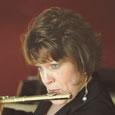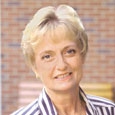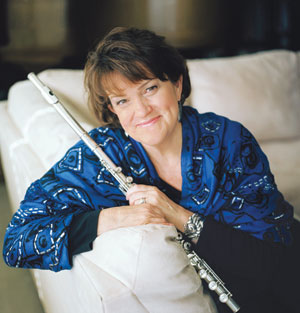 Holly Hofmann is the quintessential jazz flutist with a complete foundation of musical knowledge and training. She has also fought – and continues to fight – the preconceived ideas that the flute and women don’t belong in jazz.
Holly Hofmann is the quintessential jazz flutist with a complete foundation of musical knowledge and training. She has also fought – and continues to fight – the preconceived ideas that the flute and women don’t belong in jazz.
Holly Hofmann grew up near Cleveland, Ohio, the daughter of a jazz guitarist and a stay-at-home mother. Jazz was in her life, almost from the beginning. A plastic flute similar to a recorder was her first instrument, and she started playing it with her father at age four. “I really started jazz from the beginning because my Dad was a jazz guitarist. At five I was playing jazz standards by ear on a Flutophone with my Dad. I wasn’t reading music yet, so he would sing a line of a jazz standard, maybe the first four bars of the tune, and I would play it back. When I knew the tune, we would play it together.”
She transitioned to recorder at six and by age seven had her first silver flute. “I knew about 7 or 8 standard jazz tunes by that time. Of course, it helped that there was music played in the house all the time.”
Hofmann was not only learning the tunes as her father sang them to her but was also becoming acquainted with jazz style at the same time.
She has a huge flute sound and says it is the result of never playing with a tight embouchure. “My first teacher, Walter Mayhall, started me on the flute with a bottle and then the headjoint. He was teaching at Youngstown State University at the time, but he came up to Cleveland to teach as well. His assessment of my potential was, ‘She’s going to be a natural. She needs to go to Sharp.”
So Hofmann soon switched to Maurice Sharp, the Cleveland Symphony Orchestra’s legendary principal flutist. The background she received there was completely traditional, Classical, and disciplined. She did not play jazz in junior high and high school. “They didn’t want me in the jazz band, and they didn’t want a girl on the bus when they went on trips. I wasn’t encouraged to play jazz outside of home at all. They just said, ‘No, no, no. There’s nothing for you to do.’”
The assumption that girls could and should not play jazz was firmly intrenched in the 1970s, but that was not her only hurdle. There was also a traditionally held belief that the flute was not a suitable jazz instrument. I asked if those prejudices have changed, and Hofmann responded in a qualified voice, “To some extent. Female jazz flutists are still dealing with that. When I do clinics, girls come up to me all the time and say that their band director tells them that, unless they double on saxophone, they can’t play in the jazz band. That said, the traditional view about flute as a jazz instrument has improved a little. Some public school music programs provide good educational opportunities for all instruments, but quite a few don’t.” 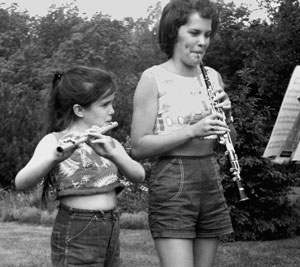
When she was in high school, the band director told her she would never have a career in jazz because she wouldn’t double on saxophone. She had the satisfaction recently of playing a concert in Cleveland, and although the director who gave her that negative advice did not attend, his associate did.
Because she studied with Sharp through high school, enrolling at the Cleveland Institute of Music for college was a natural transition. “Maurice Sharp said absolutely no jazz while I was studying Classical music. Even though he had played in jazz bands when he lived in Wyoming, he thought playing jazz made classical players a bit sloppy. I still played jazz at home and with my friends, but there was very little time to do anything but practice the ensemble music, music for my lessons, and study.”
She says that Sharp’s major influence on her playing was “the art of phrasing, and concept of sonority, even while playing softly.” While Sharp is known for his latter-day vibrato style, “he wasn’t terribly fussy about vibrato. I completely disengaged from all of that type of vibrato when I started recording and playing jazz for a living. I would say that probably 50% of the time I don’t use any vibrato at all now.”
.jpg) Upon receiving her undergraduate degree, Hofmann had to decide what to do with her life. “I got a lot of advice from teachers and my parents, who thought it would be hard for me to establish a career as a jazz flutist. They urged me to get a masters so I could teach at the college level if necessary, so I went to the University of Northern Colorado, which is in Greeley. I was a teaching assistant there, which helped pay for graduate school. After finishing the Master of Music program, I started working on a doctorate and finished most of the course work for that.
Upon receiving her undergraduate degree, Hofmann had to decide what to do with her life. “I got a lot of advice from teachers and my parents, who thought it would be hard for me to establish a career as a jazz flutist. They urged me to get a masters so I could teach at the college level if necessary, so I went to the University of Northern Colorado, which is in Greeley. I was a teaching assistant there, which helped pay for graduate school. After finishing the Master of Music program, I started working on a doctorate and finished most of the course work for that.
“I was playing a lot of jazz in Greeley and Denver and was pretty sure that I could get past the fact that I didn’t double. I just had a feeling that, even if I had to have another job, which I never did, that I could do it.” She had a flutist friend in San Diego who was taking a sabbatical, so Hofmann moved to the West Coast to work as her friend’s replacement. The substitute position did not work out, but she fell in love with San Diego and decided to stay.
She started working almost immediately and met pianist Mike Wofford, with whom she would perform and record. Many years later they married. She also began recording for Capri. “The first session for my first recording was done in 1989, and the CD came out a year later on the Denver label. Interestingly, they hadn’t been interested in me when I lived in Colorado, but when I moved to California they found me more desireable. Then I started touring, and slowly but surely, I discovered that I could work from San Diego. I got an agent about that time as well.”
Jam Sessions
During the summers Hofmann studied with Frank Wess, who had played saxophone and flute with Count Basie, Zoot Sims, and many other jazz greats. I admitted that, while familiar with the makeup of a classical flute lesson, I didn’t know what a jazz lesson includes. She replied, “There is a lot of jamming with the teacher in a jazz lesson. However, one of the big benefits of studying with Frank was that he took me to jam sessions. There were no women at jam sessions in those days, and he made me go and stand up in front of the band and improvise for all those guys. It was the most intimidating scenario I can even imagine, but I did it.
“I was right at the end of the era when jam sessions were the way that jazz players learned their trade – by meeting in informal groups to play together. Famous musicians held these jam sessions. There was one on Bleecker Street that went on weekly for years. The great jazz pianist Barry Harris was the one who held it. Wess thought it was important for me to go to these sessions, to get out there and do it. I had some teary moments from time to time. Some of the guys were very nice, and some of them were brutal.
“I was studying the compositional side of jazz with Slide Hampton at the same time, and he gave me a list of tunes often played in jam sessions. They were mostly up-tempo tunes associated with Charlie Parker, such as Confirmation and Groovin High done at break-neck tempo. Playing them in a session was the moment of truth. I worked on those tunes like crazy so I wouldn’t embarrass myself.
“Jam sessions were held in warehouse backrooms or in clubs after-hours. At one or two in the morning, when players were done with their gigs, they would go to these after-hour jam sessions. All of my mentors encouraged me to attend, but they said if you don’t know all the tunes, and you can’t deliver the goods on the spot, a career in jazz is going to be hard for you to establish.
“Knowing the tunes is not part of the repertoire for young jazz players today, although I think it ought to be. The experience of having to play on the spot by ear, even when I didn’t know the melody, was invaluable. The essence of a jam session is having the ability to listen to other musicians play a melody and then be able to improvise on it by ear. This ability is also what young musicians are missing today. If they don’t have the chart in front of them, they can’t play the tune. Jazz is an improvised music that requires a lot of ear training. What those jam sessions did was require me to pick up tunes by ear.”
Classical vs. Jazz Flute
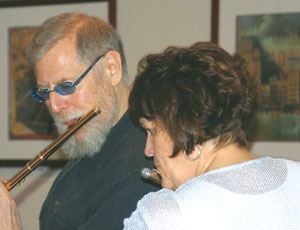
(Holly rehearsing with Lew Tabackin at the 2009 NFA convention in New York)
Hofmann draws a distinction between instruments traditionally used in jazz, such as saxophones and trumpets, and flutes. She says that the difference is based in how a player approaches the instrument. “I play the flute more like a jazz horn and not as a flute. Some of the major jazz saxophone players just burn on their saxophones, but when they pick up their flute what comes out is all very light and fluffy. They don’t dig in on the flute the way they do on their saxophones.
“After my classical flute days I made many changes in my playing to bring the instrument into the jazz flute vernacular. One of those changes was vibrato. I hardly use vibrato anymore. There are a number of jazz flutists who use Classical flute vibrato, which bothers me to no end.
“The attacks and ends of notes are another major change; I don’t taper the end of every note anymore the way Classical players are taught to do. In jazz, articulation is used more for emphasis and to make the music swing. Jazz articulation becomes a part of rhythm. Perhaps these differences are a result of not having flute records to listen to when I was young. I only heard my father’s big band records, and those were mostly trumpet and saxophone solos. I had piano trios and saxophone players on recordings, so that was what I thought jazz was supposed to sound like.”
The Jazz Flute Battle
The uphill climb that female jazz flutists face is not merely traditional sexism but also a strong prejudice against the flute in the field of jazz at all. That Hofmann and other female jazz flutists, such as Ali Ryerson and Anne Drummond, have established careers in the field is a strong testament to their tenacity and talent. “I get tired of the battle. I keep having this feeling that I will see this change in my lifetime, but now I think that’s doubtful. I’m the wrong sex, play the wrong instrument, and live on the wrong coast to be a jazz musician. Believe me – I have turned a lot of people around, but there are still promoters who don’t want jazz flute on a festival. That kind of thinking remains rampant.
“One of the reasons for this pervasive belief is that the instrument doesn’t have a long jazz history; you can name all of the jazz flute players who are household names on one hand but there are hundreds of saxophone and trumpet players. There haven’t been enough jazz flute predecessors, so nobody knows what jazz flute should sound like. For a while everybody thought that jazz flute should sound like it did when doublers played it. The preconception about women playing jazz flute is that it’s going to be feminine and light.”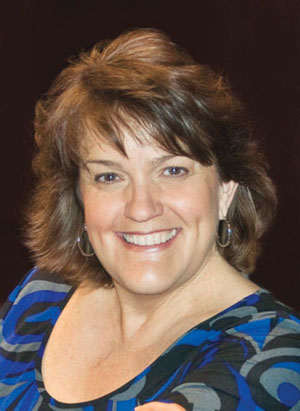
For classical flutists who also play jazz, she comments, “You have to get the chops, the technique and discipline, which is great from an early exposure to classical training. However, what happens along the way with classical musicians who don’t play jazz until later in life is that they get married to the printed note, and they are never able to free themselves from that. They are also afraid of playing wrong notes. I can listen to a so-called jazz flutist and in 16 bars tell whether they are rooted in classical music. I make that judgement based upon their improvisation and how safe they are playing.”
Hofmann and jazz pianist Mike Wofford were married in 2000. His was the pianist and music director for Sarah Vaughan and Ella Fitzgerald. It was during this time that he appeared on his first jazz recordings with Mel Torme, Gary Burton, and Joe Pass. Also a composer and arranger, Wofford has written charts for Hofmann’s latest projects, tributes to Antonio Carlos Jobim (scored for piano, bass, drums, flute, and Brazilian percussionist with 14-piece string orchestra) and Duke Ellington (scored for piano, bass, drums, and flute with 14-piece string orchestra). “We are taking both of these books on tour, and they are actually beginning to catch on. Orchestras are looking for programs that will draw new audiences in, and these programs do that. They are performed acoustically without amplification.”
Plans are in the works to record these two projects, but recording with symphony orchestras can be expensive. The Brazilian rhythms required in the Jobim book are not in the traditional American musician’s background, and rehearsal time would be extensive to do them correctly. “There’s no 1 and 3 in Brazilian music, and we are pretty indoctrinated in a standard 44 kind of thinking.” She is seeking sponsorship to record both books in the future.
The Recordings
Hofmann has been recording since 1989, so a vast audio archive exists. “I have 11 CDs as a leader, including a new January 2010 release with pianist Bill Cunlisse.” Her recordings include Take Note, Further Adventures, Minor Miracle, Live at the Athenaeum, and Three’s Company, all on the Capri label. Duo Personality was recorded for Concord Jazz Alliance, and she did Tales of Hofmann, Just Duet, Flutopia, Live at Birdland, and Just Duet, Vol. 2 on the Azica label.
